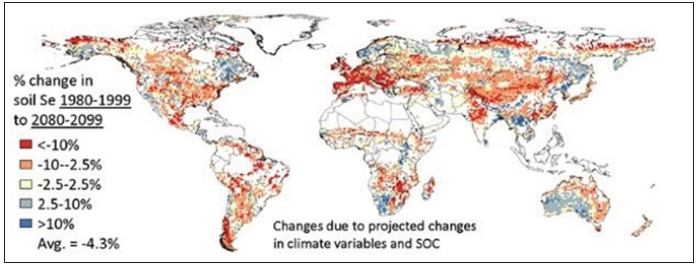- Submissions

Full Text
Environmental Analysis & Ecology Studies
Soil, Food, Health, and the Environment
Penelope Nagel*
USA
*Corresponding author: Penelope Nagel, 9404 Genesee Ave Suite 340, La Jolla, CA, 92037, United States
Submission: November 25, 2020Published: April 16, 2021

ISSN 2578-0336 Volume8 Issue2
Introduction
Many people believe that the rise in autoimmune diseases, cancers, allergies and memory disorders are partially due to an improvement in health diagnostics, yet the clear answer lies in our food supply and the ground beneath our feet, soil health.
Growing concerns over health and wellness correlate directly into deficits in our soils. When beneficial minerals are not available to plants via the soil, it ceases to exist in our food which translates into vitamin deficient people that are more susceptible to illness. The top deficits include
1. Calcium deficiency which contributes to muscle spasms, low bone density and hypocalcemia.
2. Low Sodium levels contribute to gastrointestinal distress and improper functioning of nerves and muscles.
3. Low phosphorous levels cause weak bones and muscles, joint pain, nervous system disorders and obesity.
4. Zinc deficiency causes poor immune function.
5. Low selenium levels contribute to the body’s cells inability to process and protect against many diseases Selenium is required for a healthy immune system and must be obtained through dietary sources. It is also essential for the synthesis of numerous proteins. Up to 1 billion people are thought to be affected by low dietary selenium intake.
These rising health concerns directly corelate to the nutritional value of our food.
“A Kushi Institute analysis of nutrient data from 1975 to 1997 found that average calcium levels in 12 fresh vegetables dropped 27 percent; iron levels 37 percent; vitamin A levels 21 percent, and vitamin C levels 30 percent. A similar study of British nutrient data from 1930 to 1980, published in the British Food Journal, found that in 20 vegetables the average calcium content had declined 19 percent; iron 22 percent; and potassium 14 percent. Yet another study concluded that one would have to eat eight oranges today to derive the same amount of Vitamin A as our grandparents would have gotten from one.”
Courtesy of https://www.scientificamerican.com/article/soil-depletion-aNDNUTRITION- LOSS/
Understanding our soil is essential to promoting human and animal health. The process of guaranteeing our food supply while maintaining the integrity of food quality requires fertilizer inputs. The crux of the problem is the where to put these inputs, how much and which type of inputs to add which requires testing. The cost to farmers and level of granularity which these tests are performed is important piece of solving this dilemma that affects our food, our environment, and our health. Fertilizer prescriptions maps require more granular data to improve nutrient value of the crop, assist in environmental controls, make the growing nutritious crops profitable for the grower.
Advanced technology-powered soil analytics can process data in a more efficient mechanism than the conventional chemical wet lab system to analyze nutrients in the soil. Farmers and agronomists can obtain rapid soil analysis through the sensors at an ultra-low cost for what we believe is a more efficient, soil analysis experience. The ability to grow more with less inputs is part of the United Nations Sustainable Development Goals (SDG’s). A focus on healthy soils promotes nutritious food but must be done with an understanding of the microbiome in the soil and how that influences the plant and human and animal health (Figure 1).
Figure 1: Courtesy of: Selenium deficiency promoted by climate change ETH Zurich https://ethz.ch/en/newsadnd- events/eth-news/news/2017/02/selenium-deficiency-promoted-by-climate-change.html

Current acceptance of artificial nutrient supplements in food and amendments in agricultural inputs requires advanced research and education. For example, eating foods that have a strong relationship for absorption is needed for both humans and plants. Often these relationships or synergistic affects are not taken into consideration. One of these relationships required for a plant to process nitrogen is sulfur, which must be present in the correct ratio to aid in plant development. The same exists for phosphorous with zinc. With a zinc deficit in soils across the globe it is easy to trace the problem of why humans are experiencing increased incidences of zinc deficiency.
We might be growing more food than has historically been achieved, but to get the same nutrients that our ancestors derived we are required to eat 2-10 times more to get our daily requirements, which can lead to empty calories creating obesity problems. The solution to these problems is better knowledge of our soil to prevent the effects of applying the wrong fertilizer in the wrong amounts and wrong places.
It is essential to our survival for humans to understand our soil and our relationship to nature. A healthy planet will promote our longevity if we promote the balance of nature: air, soil, and water. It is in the nest interest of our health and climate to promote healthy soils through increased nutrient management for our food and our environment.
© 2021 Chengjun Wang. This is an open access article distributed under the terms of the Creative Commons Attribution License , which permits unrestricted use, distribution, and build upon your work non-commercially.
 a Creative Commons Attribution 4.0 International License. Based on a work at www.crimsonpublishers.com.
Best viewed in
a Creative Commons Attribution 4.0 International License. Based on a work at www.crimsonpublishers.com.
Best viewed in 







.jpg)






























 Editorial Board Registrations
Editorial Board Registrations Submit your Article
Submit your Article Refer a Friend
Refer a Friend Advertise With Us
Advertise With Us
.jpg)






.jpg)














.bmp)
.jpg)
.png)
.jpg)










.jpg)






.png)

.png)



.png)






